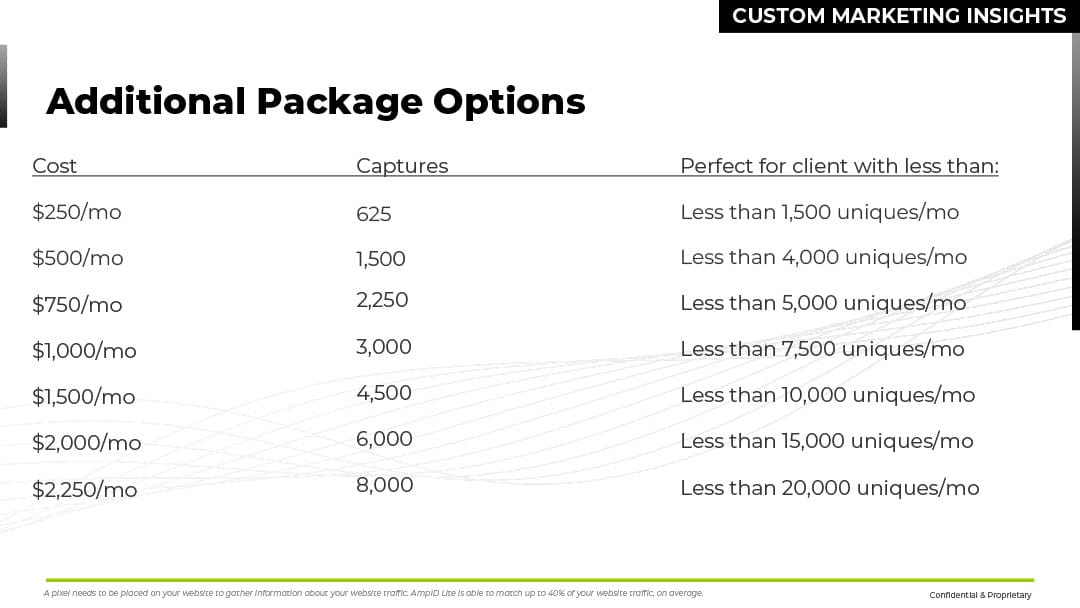People growing up in a small town were able to witness the power of local advertising firsthand. It was the mom-and-pop shops, with their personalized messages and community-focused approach, that captured the attention and loyalty of potential customers.
Now, as national brands seek to expand their reach in a much more personalizes way, they are realizing the strategic advantage of exploring local advertising. By tapping into specific markets and connecting with consumers on a more personal level, your brand can establish a stronger presence in communities and gain a competitive edge.
Today we want to help you in ‘Navigating Small Ponds’ – adapting big brand marketing efforts to fit the dynamics of local markets.
We’ll explore how this approach empowers big brands to connect authentically with local audiences and build meaningful relationships. We’ll delve into the unique synergy between Amplified Digital Agency’s expertise in crafting effective local advertising strategies, and Lee Enterprises’ resource-rich platforms for reaching local audiences.
Are you a big brand struggling to connect with potential customers on a personal level? Look no further! We have the solution for you.
The Power and Reach of Potential Customers in Local Markets

Understanding the value of targeting potential customers locally
Understanding the needs, preferences, and behaviors of potential customers is crucial for successful local advertising campaigns. By gaining insights into their target market, businesses can tailor their marketing efforts to effectively reach and engage these potential customers. This targeted approach allows businesses to maximize their return on investment in local markets by focusing their resources on those most likely to convert into loyal customers.
Engaging a target audience in meaningful ways is key to building brand loyalty and driving long-term success in local contexts. When businesses connect with locals on a personal level, they become advocates for the product or service. This word-of-mouth advertising takes hold and spreads to neighboring communities, expanding the reach beyond the initial target market. By tapping into the power of potential customers within local markets, businesses can create a ripple effect that amplifies their brand’s presence and impact.
The impact of local advertisements: Case Studies and Success Metrics
| HIGH IMPACT REVEALS | RUN OF SITE IMPRESSIONS | |||||
| APPLIANCE RETAILER | HOSPITAL GROUP | CAR DEALER | GROCERY | CHARITY / NON-PROFIT | REAL ESTATE | |
| Our Results | 1,100,800 reveal impressions 3,450 clicks, 0.31% CTR | 446,600 reveal impressions 3,000 clicks, 0.67% CTR | 46,000 reveal impressions 110 clicks, 0.23% CTR | 1,162,000 ROS impressions 1,330 clicks, 0.11% CTR | 693,000 ROS impressions 600 clicks, 0.09% CTR | 105,000 ROS impressions 220 clicks, 0.21% CTR |
| Performance Benchmarks: 0.20% click thru rate | Performance Benchmarks: 0.06% click thru rate | |||||
As seen in the examples above, we are able to outperform industry benchmarks, which means you get a lot more clicks from highly engaged traffic.
Lee Enterprises’ recognition as a growing local media digital subscription platform
Lee Enterprises has established itself as a leading digital subscription platform for local media, offering access to a wide range of trusted news sources. This growth presents national brands with an ideal avenue to reach engaged local audiences and tap into the credibility and reach of trusted local news sites.
By partnering with Lee Enterprises’ digital news platforms, national brands can leverage the platform’s extensive network to connect with potential customers in various local markets. This collaboration allows businesses to expand their reach beyond traditional advertising channels and tap into the influence and trust that established local media outlets possess.
Lee Enterprises is the outlet for targeted, local advertising, and their subsidiary, Amplified Local, is the creative and strategic experts to help you reach these targeted audiences in the right way.
By combining the resources of these two powerhouse companies, your brand can reach the market you want in a way that truly speaks to people.
The Unique Appeal and Effectiveness of Local Advertisements
Amplified Digital Agency’s Role in Crafting Effective Local Advertising Strategies
Amplified Digital Agency excels at developing tailored local advertising strategies that cater to the unique needs of each market. Our expertise lies in audience targeting, creative messaging, and campaign optimization, enabling national brands to maximize their impact at the local level.
By ensuring that local advertising campaigns effectively connect with target audiences and drive desired outcomes, Amplified Digital Agency helps businesses tap into the full potential of their customer base.
Creating Ads That Resonate with Local Audiences
Understanding the cultural nuances and preferences of different local audiences is crucial for crafting ads that truly resonate. At Amplified Digital Agency we possess this understanding, allowing us to create compelling ad content that captures attention and drives engagement.
By leveraging insights into local consumer behavior, we develop creative concepts aligned with the values, interests, and aspirations of specific communities. This approach ensures that advertisements are not only seen, but also genuinely connect with potential customers on a deeper level.
Utilizing Data-Driven Insights for Targeted Local Campaigns
Data analytics play a pivotal role in Amplified Digital Agency’s ability to deliver targeted local campaigns. We leverage data-driven insights to identify key audience segments within specific markets, enabling precise audience targeting. By delivering ads to the most relevant potential customers in each locality, businesses can significantly increase their chances of generating meaningful leads and conversions.
Furthermore, we continuously analyzes campaign performance metrics to optimize local advertising strategies and maximize return on investment (ROI). This data-driven approach allows businesses to adapt their marketing efforts based on real-time feedback from their target audience. It ensures that resources are allocated efficiently towards channels and tactics that yield the best results.
In addition to traditional advertising, our innovating ad methods such as High Impact Reveal Ads, Standard Display Ads, In-Banner Video Ads, Native Ads, Video Ads, and Local Email Marketing Campaigns have proven to be effective for big businesses. These strategies help in building brand awareness, driving website traffic, and increasing sales. By strategically utilizing these advertising channels, businesses can reach potential customers where they spend a significant amount of their time – online.
The Strategic Benefits of ‘Owned and Operated’ Ads

Owned and operated ads offer businesses full profit potential by allowing them to directly control their advertising strategies. By utilizing owned and operated ads, companies can build stronger customer relationships and expand their customer base through targeted content marketing.
These ads provide an opportunity for businesses to conduct potential customer analysis, generating valuable leads and potential clients.
Explaining ‘Owned and Operated’ ads in the local advertising landscape.
‘Owned and Operated’ (O&O) ads refer to advertisements placed directly on platforms owned by Lee Enterprises, such as their digital news sites. O&O ads provide national brands with a direct channel to engage with local audiences through trusted media outlets.
This approach allows businesses to tap into specific markets and target potential customers effectively.
Benefits of O&O ads: community engagement, trust, and relevance.
O&O ads foster community engagement by appearing alongside relevant local content, enhancing brand perception among local audiences. Placing ads on Lee Enterprises’ platforms builds trust as consumers associate the brand with trusted local news sources. This association creates a sense of credibility that resonates with potential customers.
Moreover, O&O ads ensure relevance by reaching potential customers who are actively seeking information and updates from their local communities. By aligning advertisements with the interests of the target audience, businesses increase the likelihood of capturing their attention and driving conversions.
Lee Enterprises’ role in providing the ideal platform for these ads.
Lee Enterprises offers a network of high-quality digital platforms that attract engaged local audiences, making it an ideal platform for O&O ads. The extensive reach of Lee Enterprises’ platforms ensures that O&O ads have maximum exposure to potential customers in specific markets. With its established reputation and strong presence in local communities, Lee Enterprises provides a trusted environment for national brands to showcase their offerings.
By partnering with Lee Enterprises, businesses gain access to a vast pool of prospective customers who are already engaged with local news and content. This targeted approach increases the chances of reaching potential customers who are more likely to be interested in the products or services being advertised.
Crafting a Localized Strategy with Amplified Digital Agency
Amplified Digital Agency specializes in crafting localized marketing strategies for targeting specific industries and markets. Their expertise lies in creating comprehensive marketing strategies that go beyond owned and operated (O&O) platforms, encompassing all forms of advertising purchased through the agency. This approach ensures a cohesive and integrated marketing plan that effectively reaches the target audience.
One of the key components of Amplified Digital Agency’s strategy is leveraging content marketing, social media, and advertising to amplify brand visibility and drive results. By understanding the unique needs of each company and product, they can tailor their strategies to align with the goals and objectives of their clients.
The agency’s guidance helps businesses refine their messaging, targeting, and overall strategy to maximize the impact of their local advertising efforts. Through careful analysis of data on platform usage and audience preferences, Amplified Digital Agency assists businesses in identifying the most suitable Lee Enterprises’ platforms for specific markets.
Strategic selection of Lee Enterprises’ platforms ensures that local advertising campaigns effectively reach potential customers in targeted markets. By leveraging these platforms’ extensive reach and diverse audience demographics, businesses can connect with their desired target market more efficiently.
Implementing a successful local advertising campaign requires several steps.
First, clear objectives must be defined to guide the overall strategy.
Next, identifying the target audience is crucial to tailor the messaging and content accordingly. Crafting compelling ad content that resonates with the target audience is essential for capturing their attention.
Once the strategy and content are in place, selecting appropriate platforms is a critical decision. Amplified Digital Agency’s expertise comes into play here, helping businesses choose the right Lee Enterprises’ platforms based on data-driven insights.
Execution of the campaign involves careful planning, including budget allocation, campaign scheduling, and monitoring performance metrics. Regular evaluation and optimization are essential to ensure that the campaign is delivering desired results and maximizing return on investment (ROI).
Overcoming Challenges in Local Market Engagement

Addressing common challenges in local advertising.
Local advertising can present several challenges, including stiff competition from other local businesses and the need to understand diverse market dynamics. However, these obstacles can be overcome through strategic planning, creative problem-solving, and utilizing the expertise of Amplified Digital Agency and Lee Enterprises.
By acknowledging and tackling these common challenges head-on, national brands have the opportunity to unlock the full potential of local advertising and achieve success in specific markets.
Adapting national messages to fit local cultures with Amplified Digital Agency’s help.
Amplified Digital Agency specializes in assisting national brands in tailoring their messaging to align with the unique cultural nuances of different local markets. This tailored approach ensures that national messages resonate with local audiences while avoiding cultural missteps or misunderstandings. By adapting their messaging to fit each specific market, businesses can establish a deeper connection with potential customers and foster brand loyalty.
Measuring the effectiveness of local campaigns.
To measure the effectiveness of local campaigns on O&O sites, it is crucial to track key performance indicators (KPIs) such as click-through rates, conversions, and engagement metrics.
Utilizing analytics tools provides valuable insights into campaign performance, allowing businesses to optimize their strategies for better results. Continuous monitoring and analysis enable businesses to make data-driven decisions and refine their approach to maximize the impact of their local campaigns.
By leveraging Lee Enterprises’ platforms for measurement and analysis, businesses gain a comprehensive understanding of how well their campaigns are performing at a granular level.
The Amplified Digital-Lee Enterprises Connection
Deep diving into the synergy between Amplified Digital Agency’s marketing solutions and Lee Enterprises’ resource-rich platforms.
Exploring the synergy between Amplified Digital Agency’s marketing solutions and Lee Enterprises’ platforms reveals a powerful local advertising ecosystem. By leveraging data-driven insights, the agency’s marketing solutions inform campaign strategies, while Lee Enterprises’ resource-rich platforms provide extensive reach and credibility.
This collaboration between Amplified Digital Agency and Lee Enterprises delivers comprehensive solutions for national brands aiming to penetrate local markets effectively. The combination of targeted marketing strategies with trusted media platforms maximizes brand visibility, engagement, and conversions at the local level.
National brands can take advantage of this partnership to establish a strong presence in specific markets and connect with potential customers on a deeper level. By tapping into the extensive reach of Lee Enterprises’ platforms, these brands can ensure their messages are seen by a wide audience. This increased exposure helps build brand recognition and trust among potential customers.
Furthermore, Amplified Digital Agency’s data-driven approach ensures that national brands can target their campaigns effectively. By analyzing consumer behavior patterns and preferences, the agency can create highly personalized messaging that resonates with local audiences. This tailored approach increases the chances of capturing the attention of potential customers and driving them towards conversion.
The collaboration between Amplified Digital Agency and Lee Enterprises also offers national brands access to valuable resources that enhance their marketing efforts. With Lee Enterprises’ rich platform offerings, such as newspapers, websites, and social media channels, brands gain multiple touchpoints to engage with their target audience.
National brands partnering with Amplified Digital Agency benefit from the credibility associated with Lee Enterprises’ reputable publications. Being featured in trusted media outlets enhances brand reputation and instills confidence in potential customers who see these advertisements or sponsored content.
Ultimately, working with Amplified Digital Agency through its connection with Lee Enterprises provides national brands an opportunity to leverage both data-driven marketing strategies and the extensive reach of trusted media platforms. This combination empowers brands to make a significant impact in local markets, effectively connecting with potential customers and driving business growth.
Conclusion: Charting the Course for Local Advertising Success
Congratulations! You have now gained a deeper understanding of the power and reach of potential customers in local markets. We have explored the unique appeal and effectiveness of local advertisements, as well as the strategic benefits of ‘owned and operated’ ads. Leveraging Lee Enterprises’ local news sites for maximum reach has been a key factor in crafting successful localized strategies. Overcoming challenges in local market engagement is no longer an obstacle, as we have seen with the inspiring success stories of national brands on local platforms.
Now that you are armed with this knowledge, it’s time to take action and chart your own course for local advertising success.
Utilize the expertise of Amplified Digital Agency and tap into the Amplified Digital-Lee Enterprises connection to amplify your brand’s presence in local markets. Embrace the opportunities that lie ahead, and watch your business thrive as you connect with potential customers on a more personal level.
Frequently Asked Questions
How can potential customers in local markets benefit my national business?
Potential customers in local markets have immense power and reach. By targeting these individuals, you can tap into a highly engaged audience that is more likely to convert. Local customers also offer unique appeal and effectiveness for advertisements, allowing you to connect with each community on a personal level.
What are the strategic benefits of using ‘owned and operated’ ads?
‘Owned and operated’ ads provide numerous advantages. They allow you to maintain complete control over your advertising message, ensuring brand consistency and authenticity. These ads enable you to leverage the trust that customers have in local news sites, enhancing the credibility of your brand.
How can I maximize my reach using Lee Enterprises’ local news sites?
By partnering with Lee Enterprises and Amplified, you gain access to their extensive network of local news sites. This allows you to amplify your digital presence and reach a wider audience within specific geographical areas. Leveraging this partnership ensures maximum exposure for your business.
How can Amplified Digital Agency help me craft a localized strategy?
Amplified Digital Agency specializes in creating tailored strategies for businesses seeking success in local markets. Their expertise lies in understanding the unique dynamics of each community and developing customized approaches that resonate with potential customers. With their guidance, you can navigate the complexities of localized advertising effectively.
Can national brands find success on local platforms?
Absolutely! Success stories abound for national brands that have ventured into local platforms. By adapting their messaging to cater to specific communities and utilizing targeted marketing techniques, these brands have achieved remarkable results. The combination of national recognition and localized engagement offers tremendous growth opportunities.



